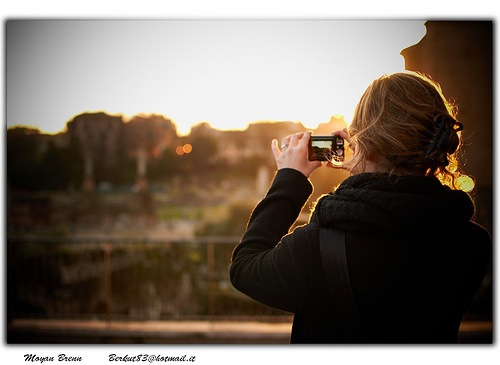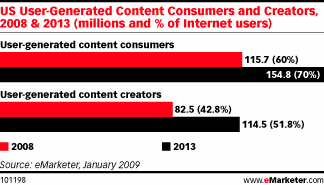
Image Credit: Moyan Brenn
You’d think “user-generated” content would be easy to use and to generate.
But few marketers really get how to effectively leverage their active networks for content marketing. They’re puzzled with how to engage users, and stumped what to do with content once they get it.
Why User-Generated Content?
User-generated content (UGC) can be a powerful source for organizations. Planned effectively, user-generated-content-marketing campaigns are one of the most cost effective marketing strategies and can reach millions of people for pennies per head. It’s estimated that 114.5 million people have contributed user-generated content in 2013.
 114.5 million is not a number to be overlooked.
114.5 million is not a number to be overlooked.
What’s the power of a 114.5 million person network? Well, according to CAPTCHA founder Luis von Ahn, it took roughly 100,000 people to build the Panama Canal, put a man on the moon, and build the pyramids of Egypt, respectively. Our network of engaged users is 1,145x the size of all the people it took to dig South America apart from Central America.
That’s pretty huge.
Now, while your business is likely not using the power of UGC providers to dig a geographically profound trench, some companies are capitalizing on the vast number of people online to help create content that engages users.
So, where do you start? Here are 5 helpful hints for UGC:
1. Get stats, data, and market research from LinkedIn.
LinkedIn is the home for online business connections and engagement. Through the LinkedIn Groups application, it’s easy to create a LinkedIn group around a topic and invite friends, colleagues and important customers. There are 1.3 million LinkedIn Groups, so make sure your group has a specific purpose or focus.
How to Generate It
When looking to your LinkedIn group for UGC, be active and engaging: ask questions, seek knowledge and involve all members. Specifically, challenge your group for:
- stats on particular topics
- industry best practices
- market research
How To Use It
Use this data for new product development, statistics for product catalogs, content ideas, and enhancing customer service or success departments.
(Extra hint: Kapost Community Manager, Andrew J. Coate, wrote an excellent piece on how to not have your LinkedIn Group suck, we recommend that as the bible for creating a rock-solid LinkedIn group. )
2. Get amazing photography/video for a fraction of the cost.
Users love posting, tagging, and creating photos and videos, especially for brands or ideas they love.
Successful UGC photo and video campaigns are creative and well-executed, and result in loads of unique pictures and social sharing. The 2009 “Best Job in the World” initiative is one of the pinnacle examples of a user-generated video campaign.
Here’s how it worked: Tourism Queensland paid one lucky winner $150,000 AUD to spend six months in Australia with free housing. To apply for the “job,” candidates submitted a 60-second video to explain why they should win. The results were astonishing. The campaign garnered more than 34,000 user-submitted videos from more than 200 countries and generated roughly $200 million in global publicity value for Tourism Queensland.
Let’s just think about the economic savings of one of those results.
Say a YouTube style 60-second video costs $3,000 to produce (a highly conservative estimate, according to several video production houses interviewed for this article). It would cost $102 million to produce the number of videos produced by users for the campaign.
Instead, say they campaign expense was $200,000 (including the cost of housing). You’ve now spent roughly $5 per video, or 0.1% of your budget from the above example.
How To Generate It
Tap into the photo- and video-rich ecosystems of Pinterest, Tumblr, Vimeo, Vine, and others. Develop a creative strategy to motivate users to participate based on their inspiration. Sometimes this can be fiscal, like Tourism Queensland’s $150,000 ante. Other times this can be more creative, like Oreo’s Instagram launch during the SuperBowl. Don’t forget to provide winners with promised goods/services in the execution.
How To Use It
Use authentically-generated photos and videos to populate your website, landing pages, blogs, video channels, point of sales pieces, social media, and even for trade show booths.
The more immediately you publicize user content, the more engaged users become. So post quickly! Your audience likes to see that their efforts are being recognized.
After responding to immediate concerns, carefully view and catalog all submissions. Take time to edit, filter, and organize the content you get. That way, you can find specific assets to support future marketing campaigns.
3. Take time to thank your crowd and analyze engagement.
Your crowd gave you a lot of great content, so be sure to thank them! Motivating an audience to engage is based in reward, according to a 2bits study. If your users feel appreciated, their chance of participating in another campaign is higher. 2bit identifies four user “points” that can help motivate people to take action:
- Psychological factors
- Mimics “gaming”
- Instant gratification
- Users strive for recognition.
How to Generate It
This time, you are generating something and giving back to your fans/followers/crowd. Rack your brain. Think of a unique and meaningful way to say Thank You. A classic example is LIFE cereal’s kid-on-a-box campaign. Quaker recognizes the fans that sent in photos of their kids by putting one on the box. Other ideas are to create automatic responses for every person who participates, whether or not they’ve won, creating a national campaign that uses components of many of the user’s content, or announcing in a public space the literal words: “Thank You.”
How To Use It
Use your moment of gratitude to capture time-sensitive data on how your crowd responds to your communication. You’ve already captured their attention, so post a few different things to see which kinds of communications do best. For instance, you could do an AB test on Facebook of a post with a photograph vs. a post with a video and track social shares.
4. Use it throughout your sales funnel.
These days, the sales funnel is hardly funnel-shaped. Instead, it’s a wayward progression through a variety of touchpoints that either you or your customers initiate. User-generated content is ideal for sales-related collateral, because it’s authentic. It’s real. It comes from an engaged audience, not an organization.
How To Generate It
Develop systems of communication between sales and marketing. Plug into the sales funnel, and the friction points within that sales process to discover areas that content might really help. Go back to user-generated photos, videos, or collateral to answer these pivotal concerns, or come up with a campaign that will both delight the user and provide sales with valuable content.
How To Use It
At this point, the “use” of your user-generated content is actually in its reuse. Reusing and repurposing user content pumps value back into your original campaign investment. Talk with your company’s various departments: customer service, customer success, sales, product, etc. and see what kinds of content they need. Make suggestions to these teams based on your library of user-created assets, or produce a new marketing piece that can be used for a specific purpose.
5. And finally, a few stats that might help you when constructing your next campaign:
- Consumers aged 35-44 contributed the most UGC. (Source: Bazaar Voice)
- 48% of consumers think that posts created by others in their networks are “a great way to discover new products, brands, trends, or retailers.” (Source: Forrester)
- One fifth of the consumer population is composed of key influencers in the purchasing activities of 74% of the population. (Source: Gatner)
- 25% of search results for the world’s top 20 brands are links to user-generated content. (Source: Socialtimes)
User-generated content, when used properly, is an effective way to engage your audience, gain valuable content, and get to know your users. It takes careful planning and an understanding of your audience, but if done effectively, it can become a go-to marketing strategy.
